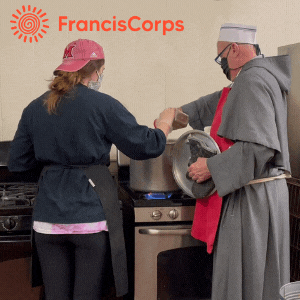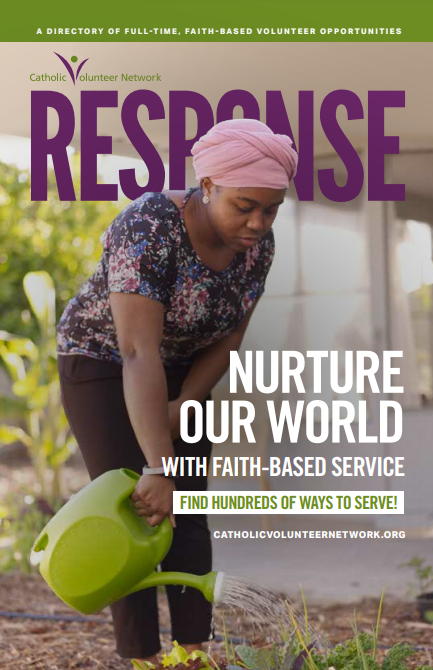“Where Are They Now?” highlights volunteer alumni who carry out the spirit of service in different professions and ministries. This month we are getting to know some alumni who have dedicated their lives to work with the homeless.
Hi! My name is Kurt Runge. I served as a Quest Volunteer in Gros Morne, Haiti in 2004. Now, I am a social worker and the Director of Advocacy at Miriam’s Kitchen, a non-profit working to end chronic homelessness in Washington, D.C.
What did a typical day of service look like for you? In the first few months, much of my time was spent among people in Gros Morne learning to speak Haitian Creole. Some days were spent teaching English to students, other days I ran an after school program for teenagers. I spent a lot of time at a church-run facility for people who are elderly, have little money, and lack the ability to care for themselves. In the summer, I was joined by American and Irish volunteers who helped to plan and manage a camp for kids in the area. In the afternoon I would often play with kids in the neighborhood or visit with people in their homes.
What is one memory from your time of service that has stuck with you? Why? I was touched by the generosity of the people I met. There were several students in my English class that I got to know well. One student in particular invited me to his home. When I arrived, they gave up their only chair for me to sit, and although they had very little, they insisted I share a meal with them. This stuck with me because it taught me that even among deep poverty, generosity has no limits. The experience serves as a constant reminder to live simply and share the gifts that have been given to me.
How has your service experience impacted your career path? Although it sounds cliché, one thing my service experience in Haiti cemented into my mind is that unbelievable inequality exists in our world, but together we have the power to change it step at a time.
In what ways did your time of faith-based service better prepare you for the work force? My volunteer experience taught me to question the systems and policies that perpetuate poverty and inequality and work to change them.
My work brings me joy because … I get to be part of an effort to end veteran and chronic homelessness in Washington, D.C. Ending homelessness means preventing homelessness whenever possible. If someone does become homeless, it means ending it quickly so no one is homeless for years. It is exciting to see many of the people Miriam’s Kitchen serves get a home of their own for the first time in many years. In the near future, D.C. will join other cities across the country like New Orleans and Houston, and end homelessness among veterans. Those cities are proof that ending homelessness is possible. I’m honored to be a small part of this effort in D.C.
How do you stay connected to your program or service site? Staying connected can be challenging. Now that I am a father of three, I am not always able to keep connected to the people I served with. However, I have many reminders of my experience there, from photographs, to artwork that serve as constant reminders of the people I had the pleasure to know and the lessons I learned.
Why serve? Marian Wright Edelman said it best: “Service is the rent we pay to be living. It is the very purpose of life and not something you do in your spare time.”
The fun stuff:
If you could get on a plane and travel to one place you’ve never visited where would you go and why? I would go to Ecuador. My wife studied abroad and volunteered in Ecuador and fell in love with the country. I have heard so many stories about it that I would love to experience it with her.
If you could be either a dog or a cat which would you be and why? A dog of course!
Hi! My name is Jordan Skarr. I served with Jesuit Volunteer Corps Northwest in Tacoma, WA from 2004-2005 and the Magis Program at Loyola University Chicago from 2006-2008. Currently I serve as the Director of Programs for the Ignatian Spirituality Project, a Jesuit ministry dedicated to sharing the gift of the Spiritual Exercises with those persons experiencing homelessness.
What did a typical day of service look like for you? I worked at an agency called Nativity House. Its mission is to provide a place of refuge for persons experiencing homelessness during the day. My placement there was a wonderful composite of responsibilities including making 25 gallons of soup, learning how to play spades, and most importantly building a ministry of presence with the guests, many who found their time at Nativity House the one bright spot in an otherwise bleak day.
What is one memory from your time of service that has stuck with you? Why? The average day at Nativity House was loud, busy and chaotic. Hundreds of people would walk through our doors in need of a place to sit out of the rain, a warm cup of coffee, and a chance to enjoy the company of their community in a safe place. One day a young man, a few years my junior, pulled me aside and asked for a quiet place to talk. We pulled a couple of chairs together in the corner of the modest chapel and closed the door. He was shaking as he began: “I’ve been off heroin now for three days and I’m nervous I’m going to use again… will you pray with me?” We said a quiet prayer together and went to get some lunch. That moment, so humble and so honest, has stayed with me because it clarified for me what my service “year” was all about: building relationships that make a difference. It galvanized my conviction that I wanted to continue in this ministry.
How has your service experience impacted your career path? We collaborate across the country with 12-step based transitional housing facilities to offer folks a retreat experience that is life changing. That moment in the chapel, where the small flicker of recovery first was found, is in my mind, kindled throughout our retreats.
In what ways did your time of faith-based service better prepare you for the work force? We spent a lot of time “debriefing” at the close of the workday – we would intentionally take the time to process our time together. In a lot of ways, this was very similar to the Jesuit tradition of praying the “Examen,” a practice that invites mining one’s experience for the presence of God. Some days, both then and now, it is easier that others to see or to feel God’s presence; yet these quiet moments help sustain, inspire and energize for the next.
My work brings me joy because … It’s a great privilege to bear witness to some incredible transformations. This ministry is powerful not just for our participants, but for the volunteers as well.
Do you have any advice for volunteers who are wrapping up their year and transitioning out of their time of service? Any time of transition can be a minefield and I found it helpful to simply name and recognize the time for what it was. Keep in touch with your communi and find alumni, any way to keep connected to folks who have “been there.”
How do you stay connected to your program or service site? My wife Megan, a fellow FJV, and I were invited to be support people for our local community; this was a great way to stay connected. We invited them over for dinner, explained what snow was for the southern natives, and prayed together during spirituality nights.
Why serve? In addition to deferring student loan payments, you can see a new part of the country, develop friendships that will last a lifetime, and put your faith into action.
The fun stuff:
If you could get on a plane and travel to one place you’ve never visited where would you go and why? Barcelona has been on our bucket list for a while.
If you could be either a dog or a cat which would you be and why? I’d probably go dog because I like to run – but, cats also seem to be really good nappers, and as a young father, look for any opportunity to do that.
Hi! My name is Maureen Burke. I served with the Franciscan Capuchin Corps East (aka Cap Corps) in Washington, D.C. from 2010-2012. I now work with an organization that has pioneered the “Housing First” model, which has proven that placing individuals in housing first, then providing supportive services is the most effective way to end chronic homelessness.
What did a typical day of service look like for you? I was placed at Miriam’s Kitchen in Washington, D.C., an organization that works with men and women experiencing homelessness. Miriam’s Kitchen serves fantastic meals every day, getting fresh produce from farmer’s markets and the White House garden. Miriam’s Kitchen also provides case management, art and writing therapy, yoga, guest-lead advocacy groups, and permanent supportive housing. I served as a case manager and every day was a new day. Whether I was writing out a clothing referral for the hundredth time, listening to a man talk about his “bedazzled” necklaces, handing out toiletries, testifying in front of the city council, or advocating for more affordable housing, I rejoiced in the tasks at hand.
What is one memory from your time of service that has stuck with you? Why?At Miriam’s Kitchen, when we felt our hearts overflowing because of the strength, resilience, and courage we found in the work of our clients, we would bring our hand to our chest and call that moment a “heartpat.” One day, a client who I had been working with for months, and who was particularly challenging to engage, reached into my bag and pulled out my grandmother’s rosary. I attempted to set boundaries, as a good case manager should, and told the client that he was not to go into other people’s belongings and that the rosary was mine. The client was not receptive and proceeded to place the rosary around his neck, look me straight in the eye, and say, “No, Maureen! It’s mine!” He walked out of the office and I was sure I would never see my grandmother’s rosary again. Months later, the client returned, walked up to me and said, “Hey Maureen! You know that necklace you gave to me?” [patting his heart where the rosary fell] “I still got it.” That moment, that heart pat, will always remain with me because it was a time that brought me out of my “clinical, case management-self” and made me recognize that this client and I were on the same journey and that perhaps we both needed a little assistance from my grandmother’s rosary to get home.
What inspired you to serve? “Service is the rent we pay for being. It is the very purpose of life, and not something you do in your spare time.” After receiving a solid education, grounded in social justice and community at Saint Mary’s of Notre Dame, I was inspired by the lives and works of individuals like Dorothy Day, MLK JR, Saint Francis, and other saints.
How has your service experience impacted your career path? After two years at Miriam’s Kitchen, I was inspired to get my Masters in Social Work and continue working with men and women experiencing homelessness in D.C.
In what ways did your time of faith-based service better prepare you for the work force? As I continue on my career path, I am grateful for the skills and practices I picked-up in Cap Corps, including living a more intentional life-style, occasionally stepping back and reflecting on what I am doing in order to be more purposeful and effective in my work moving forward. This strength from faith gives me the confidence to show up each day for work, knowing that progress is being made, even if we can’t always see the fruits of our labor.
My work brings me joy because … I get to walk with people on their journey home. Nothing makes me happier than spending time with others and hearing their stories and hopes and dreams. My clients make me laugh, make me cry, and inspire me every day.
Do you have any advice for volunteers who are wrapping up their year and transitioning out of their time of service? Think of the values and practices that you learned in your program this year and take them with you wherever you go. Stay in touch with your community members and remember that you all survived the year together and are that much stronger because of it. You will be faced with many challenges after this year. You were labeled as a “volunteer” this year, but remember that every day, you have a choice in how you live and offer your life: You can hate something, or love every moment of the process. Find what brings you joy.
How do you stay connected to your program or service site? I work with the same client population and thus, am very lucky to be partnering with Miriam’s Kitchen in continuing to end chronic homelessness in Washington, D.C. I’m also very blessed to be near the Franciscan Brothers who supported me during Cap Corps and am always excited when I reconnect with my housemates and Cap Corp’s fearless leader, Margaret McIntyre.
Why serve? We’re all here by the grace of God and should be overwhelmed with gratitude for the joy and struggle that comes with each day. How do you want to show your thanks?
The fun stuff:
If you could get on a plane and travel to one place you’ve never visited where would you go and why? Where Saint Francis made his name of course – Assisi! I would love to walk the steps that Saint Francis walked, see the sights that made him burst into song and smile, and to feel where he found his perfect joy.
If you could be either a dog or a cat which would you be and why? Easy. Dog. Dogs are loyal and so eager to be with people AT ALL TIMES. They don’t care what society thinks of them and appear to enjoy doing really goofy things. They’re quick to forgive and will make you smile in a second. Plus, I admire their ability to take power naps and eat each meal like it’s their last – take nothing for granted. Dog is God spelled backwards and both bring joy to the world in a special way.
Final Score? Dogs – 3, Cats – 0
This article first appeared in our Staying Connected newsletter for Former Volunteers, a project done in collaboration with the Catholic Apostolate Center.
Click here to visit the Staying Connected archives.






 Thousands of faith-based service opportunities can be at your fingertips with the RESPONSE. Download the latest edition today!
Thousands of faith-based service opportunities can be at your fingertips with the RESPONSE. Download the latest edition today!
